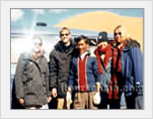
Purple Mountain Observatory Guide
-Travel to Purple Mountain Observatory Purple Mountain Observatory, also known as Zijinshan Astronomical Observatory, is an astronomical observatory located on the third peak of Zijinshan Mountain (' ?) in Nanjing, China.
Purple Mountain Observatory, also known as Zijinshan Astronomical Observatory, is an astronomical observatory located on the third peak of Zijinshan Mountain (' ?) in Nanjing, China.
The Purple Mountain Observatory (PMO) evolved from the former Institute of Astronomy, which was established in 1928 as one of the firsteightinstitutes of the Academia Sinica. In 1934, the institute completed the construction of the observatory atPurple Mountain in Nanjingand the Institute of Astronomy changed its name toPMO in 1950. PMO is known as the “Cradle of Modern Astronomy in China” not only because it was China’sfirst modern astronomical institute, but also because it was the originator of most subdisciplines of Chinese astronomy and the sponsor of subsequentCAS astronomical institutions. Of milestone significance, it symbolizes the threshold of Chinese modern astronomy.
 At the beginning, the observatory enjoyed a great reputation for its splendid architectures, rare apparatus and abundant books. The 60-centimeter-caliber reflecting telescope, the20-centimeter-caliber refracting telescope (both made in Germany) and the meridian transit made by Swiss were almost the most advanced equipment of the time. And they are still housed here. Now, it is well equipped with modern facilities used for doing experiments and observing the sun, the moon, the planets, the fixed stars and satellites.
At the beginning, the observatory enjoyed a great reputation for its splendid architectures, rare apparatus and abundant books. The 60-centimeter-caliber reflecting telescope, the20-centimeter-caliber refracting telescope (both made in Germany) and the meridian transit made by Swiss were almost the most advanced equipment of the time. And they are still housed here. Now, it is well equipped with modern facilities used for doing experiments and observing the sun, the moon, the planets, the fixed stars and satellites.
 What's more, many ancient astronomical apparatus made of bronze are also displayed here, including Armillary Sphere, Simplified Armillary Sphere and Gnomon of the Ming Dynasty (1368-1644) and Celestial Globe and Altazimuth of the Qing Dynasty (1644-1911). Armillary Sphere, designed by Zhang Heng in the Eastern Han Dynasty (25-220), was used to determine the position of the stars. Simplified Armillary Sphere, as its name indicates, is the amelioration of Armillary Sphere. It is designed by astronomer Guo Shoujing in the Yuan Dynasty (1271-1368). Gnomon, having a history of more than 3000 years, was used to measure the shadow of the sun and determine the solar terms and number of days of a year. China is the first country to know that there are 365.25 days in a year.
What's more, many ancient astronomical apparatus made of bronze are also displayed here, including Armillary Sphere, Simplified Armillary Sphere and Gnomon of the Ming Dynasty (1368-1644) and Celestial Globe and Altazimuth of the Qing Dynasty (1644-1911). Armillary Sphere, designed by Zhang Heng in the Eastern Han Dynasty (25-220), was used to determine the position of the stars. Simplified Armillary Sphere, as its name indicates, is the amelioration of Armillary Sphere. It is designed by astronomer Guo Shoujing in the Yuan Dynasty (1271-1368). Gnomon, having a history of more than 3000 years, was used to measure the shadow of the sun and determine the solar terms and number of days of a year. China is the first country to know that there are 365.25 days in a year.
The Nanjing Astronomy and History Museum is within the observatory itself. It's the first museum of its kind in China. The museum has three exhibition halls, displaying full and accurate data and pictures. Here you will feel the immensity of the universe and the smallness of human beings.
More Attractions in Nanjing
Your Question & Quick Answer*We welcome and appreciate your questions & reviews
Booking Procedures | Terms & Conditions | Payment Methods | Links | Site Map | About Us | Contact Us | Travel Agent
Copyright 2008, All rights reserved.. itourbeijing.com professional china travel guide and china travel service
TEL: 86-10-85711972 (Universal) 1-888-288-9328 (North America) E-mail: contact@itourbeijng.com
Tours Index | China Tours | Beijing Tours | Xi'an Tours | Shanghai Tours | Guilin Tours | Tibet Tours
China Travel | Beijing Travel | Shanghai Travel | Xi'an Travel | Guilin Travel |Beijing Map
China Golf | Beijing Golf | Shanghai Golf | Xiamen Golf | The Great Wall Travel | Yangtze Cruise | Travel Picture



